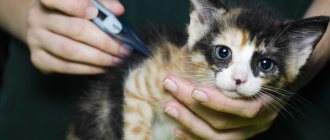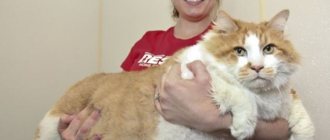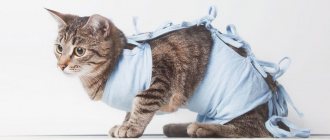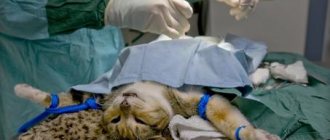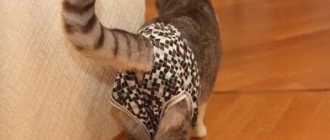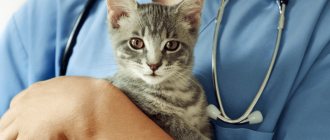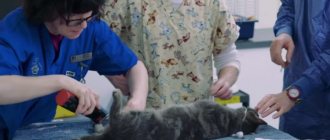It is very important for owners who are concerned about the health of their pet to make a timely decision to sterilize their pet. Because these are not only unwanted offspring, but also various diseases associated with the reproductive system in dogs.
In truth, the life of a sterilized animal is extended by twenty percent, stress is reduced, and appetite and character are improved. Well, today we will tell you how to help your pet after surgery.
Caring for a dog after sterilization: advice from a veterinarian
The global practice of sterilizing dogs that are not planned to be used in breeding dogs is gradually becoming more widespread in our country. This operation simplifies life not only for the owners (behavior changes for the better, there are no problems walking with a dog in heat and the placement of random offspring), but is also useful for the dog, protecting it from such serious, sometimes fatal diseases as pyometra, ovarian and uterine tumors and mammary glands.
With proper preparation of the dog and the professionalism of the doctor, complications are rare with any type of surgery, and recovery is quick. Postoperative care for the animal is carried out in accordance with the doctor’s recommendations, which may vary slightly in each individual case, but in general, recovery in dogs is quite easy.
The early postoperative period is recovery from anesthesia. In most cases, this happens within 2-4 hours, but it will take about a day for the animal to fully recover, during which it is better to keep an eye on the pet. Impaired breathing, weak pulse, bluish and pale mucous membranes, a significant (more than 1 degree) increase or decrease in temperature are signs that the pet needs the help of a doctor. However, such complications occur quite rarely, and mainly in older animals.
It is not recommended to place dogs recovering from anesthesia on sofas or beds - this can lead to a fall. It is better to equip the bed on the floor, away from heat sources and drafts; you can cover the animal with a blanket.
After waking up, offer your pet water, and if he refuses, lightly wet your tongue. Feeding in the first hours after surgery is undesirable, and dogs’ appetite usually wakes up later - after a few hours or the next day, then the pet can be offered small portions of soft food.
Seam processing
In most cases, caring for your dog after castration is minimal. If the animal does not have stitches removed, it is enough to simply treat the surgical field with special products prescribed by the veterinarian. Nowadays, most often they not only use absorbable material, but also apply a special indelible antiseptic gel immediately after the operation, so that care comes down to looking after the animal.
Recovery usually does not take long. Within a few hours, most castrated animals come to their senses, their behavior becomes cheerful and cheerful, they eat well and behave as before.
You can bathe a male dog that has been neutered only after the stitches have completely healed. If necessary, wash only the dog's paws or face.
Suture care after dog sterilization
Initially, the suture after sterilization of the dog is processed by the surgeon who performed the operation. After that, the patient is put on a postoperative blanket, in which your pet will walk for several days. If necessary, the doctor will also recommend wearing a special collar.
Further care consists of monitoring healing and, if necessary, treating the sutures after sterilizing the dog with an antiseptic. Antibiotic therapy may also be prescribed to exclude inflammatory processes. In the normal course of healing, this is enough. Depending on the choice of suture material and other nuances, the treatment may differ or not be required at all; your doctor will tell you about this. He will tell you whether there is a need to remove the stitches and when this can be done.
However, if the stitches become wet, fluid is released, or the dog’s temperature is lower or higher than normal, a second consultation is necessary.
Observation and care during the first days
The recovery of a female is longer and more painstaking than that of a male. Sterilization of a female is a long-term abdominal intervention, so owners will have to pay maximum attention to their pet.
The most important is the postoperative period, namely the first day. Different animals recover differently from anesthesia.
Most do this quickly and without problems, but owners still need to know some rules:
- After the operation, all vital processes in the bitch’s body are slowed down, and the temperature drops, she freezes and trembles. The animal needs to be sheltered, and at home a quiet, warm and draft-free place should be given to it. If your dog is cold, cover it up to protect it from dangerous pneumonia.
- A characteristic symptom after anesthesia is incontinence, with urine leaking constantly. If the dog is wet from incontinence, this will lead to dangerous consequences - the animal will catch a cold and get sick. A special diaper that needs to be changed often will help. If the incontinence does not go away after the stitches heal, you need to show the animal to a doctor.
- Constipation is a common condition in dogs after sterilization. If your dog doesn't go to the toilet for a few days, you should consult a doctor and give him a laxative.
- The bitch has a large cut on her stomach, it hurts her, the stitches cause discomfort, so she can lick them. This is dangerous due to infection and suture rupture, so the animal is put on a special blanket. It serves as a mechanical obstacle that prevents the integrity of the seams from being damaged. Also, a dog blanket will prevent the seams from coming apart and causing hernias.
- After anesthesia, the dog often does not eat at all. It's normal, she just doesn't feel well. You need to be alarmed if the hunger strike lasts more than three days, the animal is lethargic, motionless and clearly suffering.
- You cannot force feed or water your dog, as it may choke, and a piece or drops may get into the lungs and cause inflammation.
- Owners should carefully monitor the bitch's pulse and breathing and her behavior. Deviations are a reason to call the veterinarian.
In our clinic, the doctor will explain to the owners how to care for the dog, how long rehabilitation will take, and give the necessary recommendations for emergency cases.
Caring for a male dog after castration
Now the most terrible moment has passed - the operation was successful, the pet woke up and weakly raised its head, looking at you.
His hands stopped shaking, his heart calmed down, and the thought “It’s good that Jack easily endured castration” was floating in his head. Now the next question arises: What care is needed for a male dog after castration? Of course, your pet cannot do without you at this moment; he needs your affection and proper care in the postoperative period. In this article we will look at caring for a dog after castration.
Dog behavior after sterilization
Owners are often interested in how dogs’ behavior changes after sterilization. It is necessary to distinguish between the dog’s behavior during the period of recovery from anesthesia and how the dog’s character will change after sterilization. The deep anesthesia used during this operation can have a number of consequences visible in the animal's behavior - lack of coordination of movements, sudden aggressiveness or fear, the animal may not recognize its owners or be in the grip of hallucinations.
This is a natural reaction that passes quickly and does not require outside intervention. Be nearby, talk to your pet in a gentle voice, and if he is afraid of you or shows aggression, leave him alone and watch from the side.
The changes in character are mostly positive:
- the likelihood of escapes during estrus, dictated by sexual desire, is reduced;
- aggression towards fellow tribesmen decreases;
- the marking instinct is reduced (especially if the operation is performed at an early age, before the dogs reach puberty).
However, if before sterilization the bitch showed strong dominant qualities, sterilization will be a factor that can strengthen them, since the compensating effect of female hormones will decrease.
Other possible consequences that can result from sterilizing dogs:
- weight gain (obesity) - quite easily controlled by choosing the diet and physical activity of the dog;
- Urinary incontinence can occur mainly in large and older dogs. There are developed drug treatment regimens for such problems, on which specialists at our clinic can advise you;
- alopecia - baldness associated with hormonal imbalance is also corrected by prescribing medications that our doctors can select;
Caring for a cat after castration. Interview with a leading rehabilitation specialist
July 10, 2018
Most cats living in city apartments are neutered. Ekaterina Sergeevna Stogova, a veterinarian and leading rehabilitation specialist at the Biocontrol clinic, spoke about how to care for a pet after this operation.
— Is it true that castration of a cat is a very simple operation?
— Indeed, orchidectomy (castration) in cats is a manipulation that is technically simple to perform. But it must still be regarded as an operation. Therefore, you should not neglect a basic examination of your pet before castration. Before this procedure, patients are examined by an anesthesiologist, who determines possible risks and, if necessary, prescribes the necessary examinations. There are, for example, cat breeds that are predisposed to cardiac pathologies: British Shorthairs, Scottish Folds, Maine Coons, Sphynxes and some others. This group of patients requires an examination by a cardiologist before surgery.
— How long does it take for cats to recover from anesthesia after castration?
— During castration, combined anesthesia is used: general anesthesia and conduction anesthesia. Conduction anesthesia is the blocking of nerve impulses in the place where the anesthetic is injected, and for general anesthesia, drugs are administered intravenously. Usually the patient wakes up after castration within one to one and a half hours. But we release the animal to the owners only when the patient is ready to go home “on his own paws,” that is, no earlier than two to three hours later.
— How long does it take for stitches to heal after castration?
— During castration, two small incisions are made on the skin of the scrotum, after which no stitches are applied. The edges of the wound adjacent to each other “stick together” due to fibrin formed from exudate, which fills the “gap” created during the incisions. Wounds heal fairly quickly, usually within five to ten days.
— Do I need to wear a protective collar? How long should it be worn? Can it be removed and for how long?
- A protective collar is strictly necessary after performing this procedure. The required minimum of wearing a collar is five days after castration. The collar can be removed for a short time, but only when the animal is under your close supervision, for example, while feeding. In the case of self-traumatization - licking the surgical wound, a number of undesirable consequences occur: hematoma, infection.
— How does a cat’s behavior change after castration?
— In most cases, cats become calmer, more sociable and friendly. Their desire to share “territory” with other cats goes away, and their hormonal levels change.
— Is it true that animals can begin to gain weight after castration?
— After castration, it is important to control your pet’s body weight by observing the daily food intake. Now there is a lot of food for castrated animals. The only reminder is that the transition to a new diet should not be abrupt. It is advisable not to change the diet in the first two weeks after surgery, as this will be additional stress for the pet. It is advisable to change food gradually, over a period of five to seven days, daily reducing the amount of the usual food and increasing the amount of new food.
— Do cats mark after castration?
— If you castrate a cat in middle and older age, then the “bad habit” may not be completely eradicated. I would recommend castrating a cat starting from the age of eight months, although there is no clear opinion on this matter - there are supporters of earlier castration.
— Does a cat need special care after castration?
— After the operation, the cat can be fed four to six hours after emerging from anesthesia. In the first three days, it is advisable to use canned food: pates, pieces in jelly and the like. You need to feed the cat in small portions, three to four times a day. There are no restrictions on water consumption. It is important to control natural functions: diuresis (urination) and defecation.
— Do I need to somehow treat the postoperative area?
— In case of contamination (with tray filler, wool, etc.), we can recommend treatment with non-alcoholic antiseptics: Miramistin solution, Chlorhexidine 0.05% or Octinisept.
Irina (07/28/2018 at 10:18): Good afternoon. The cat was sterilized at the clinic. She hasn’t recovered from the anesthesia for two days now, she can’t feel her back legs, she can’t walk, she gets up and falls on her side. How long does it take for the anesthesia to wear off completely?
Reply | to write a message
Biocontrol (08/06/2018 at 14:29): Irina, in which clinic did you sterilize your cat?
Reply | to write a message
Galina (07/23/2019 at 15:51): I sterilized the cat and the next day after the operation he started bleeding. And it happened after he went to the toilet for a little while. When I went to the doctor, she scolded me, saying that I didn’t I was looking after the cat. ALTHOUGH after castration she did not suggest or say anything about the collar, etc., we had a difficult dialogue with her, etc. She put the cat under anesthesia again and cleaned it, as I understand it, because there was bleeding. Who do you think is to blame for my cat’s misfortune and should I pay for my cat’s second surgery?
Reply | to write a message
- Biocontrol (07/24/2019 at 15:15): Of course, you need to resolve the issue with the administration of the clinic where your cat was operated on. An argument confirming that you are right would be, for example, an appointment sheet that does not include a protective collar.
Reply | to write a message
Irina (09.29.2019 at 19:37): On September 20, the cat was neutered, a week later the veterinary clinic returned: the crust at the site of the incision has not decreased, but the cat feels good, is cheerful, eats, etc. They told me to put on a collar to prevent him from licking the wound. Although he didn't lick it. Put it on. On the third day of walking, traces of blood appeared on the fur in the collar. What to do?
Reply | to write a message
- Biocontrol (09/30/2019 at 16:39): Irina, hello. On this issue, it is better for you to communicate directly with our rehabilitation doctors, here:
Reply | to write a message
Ekaterina (11/18/2019 at 12:49 pm): Hello. The cat was castrated, on the 1st day he went to the toilet and his urine was dark orange, already on the 2nd day. Tell me is this normal or something needs to be done
Reply | to write a message
- Biocontrol (11.20.2019 at 15:22): Hello, Ekaterina. With this question, contact rehabilitation specialists on the forum:
Reply | to write a message
Victoria (02/18/2020 at 09:32 pm): Hello, 3 days ago the cat was neutered, swelling appeared, the cat itself is active, eats, goes to the litter box without difficulty, could the cause of the swelling be a post-operative reaction, and how to prevent it?
Reply | to write a message
- Biocontrol (02/19/2020 at 09:04): Victoria, hello! On this issue, it is better for you to communicate with rehabilitation specialists directly. This can be done on the Bioforum, in the “Questions for a rehabilitologist” section, here:
Reply | to write a message
Anna (03/24/2020 at 06:38 pm): On March 13, the Scot had a beating, the wound is still bleeding on one side and the area is swollen. The doctor came a couple of times, gave antibiotic injections and treated him with Veshnevsky ointment, said that everything would heal, but to no avail, what to do ?
Reply | to write a message
- Biocontrol (03/31/2020 at 10:39): Anna, it’s better for you to see another doctor. Consult our rehabilitation doctors, this can be done here:
Reply | to write a message
Alexandra (05/08/2020 at 12:57 pm): Good afternoon, after castration the doctor advised not to treat the wounds and “he’ll lick it himself” and sent him home. There was no talk about the collar or treatment of the wound. They injected us with anesthesia and after 5 minutes they took us away, after 5 minutes they took us out and gave us away. The cat was brought home. He hasn’t moved or breathed for two hours now. I described myself. I removed the bandage from under the ponytail and treated it with chlorhexidine. Should I continue to treat with chlorhexyline and should I get my cat a collar that will prevent him from licking himself? Kitty is 8 months old
Reply | to write a message
- Biocontrol (05/08/2020 at 17:44): Hello, Alexandra! In order to consult with our rehabilitologists, it is better to write to them on the Bioforum, in the “Questions to a rehabilitologist” section, here:
Reply | to write a message
seva (06.24.2020 at 11:35): good afternoon, we castrated a Scottish Fold cat on Friday, the next day he ate a little and so little by little only in the mornings for 3 days Yesterday and today he did not eat We give water through a syringe he became a little aggressive Please tell me the reason Is it due to stress or is there some other reason? Thanks in advance
Reply | to write a message
- Biocontrol (06/25/2020 at 11:50): Seva, hello! It is impossible to tell what is going on with your cat without an examination. One thing is for sure: if an animal refuses to eat and shows aggression after surgery, it means that not everything is in order. Be sure to show your cat to the doctor.
Reply | to write a message
Novozhilova Irina (08/06/2020 at 07:01): Hello, yesterday we had castration. Around 4:30 p.m. I recovered from anesthesia, but not completely. Today everything is already normal. The question is, how long will it take for a cat’s aggression towards another to disappear? And the second cat is also a neuter.
Reply | to write a message
- Biocontrol (06.08.2020 at 13:07): Irina, consult with our rehabilitation specialists directly on the Bioforum, in the “Questions for a rehabilitation specialist” section:
Reply | to write a message
Nata (09/03/2020 at 23:10): Good evening. The cat had surgery today. Tell me, is it normal that the doctor didn’t stitch him up, said that he was oozing, and just coated him with brilliant green? I didn’t say anything about the collar either.
Reply | to write a message
- Biocontrol (09/04/2020 at 09:03): Nata, hello! You can ask our rehabilitation specialists questions at the Bioforum, here:
Reply | to write a message
Love (11/29/2020 at 10:19 pm): 11/28/2020 Scottish Fold, cryptorchid, was neutered, more than a day has passed, he is refusing water and food, we are very worried
Reply | to write a message
- Biocontrol (11/30/2020 at 09:07): Love, hello! On this issue, it is better for you to consult with our rehabilitation specialists directly. This can be done on the Bioforum, in the “Questions for a rehabilitator” section:
Reply | to write a message
Alesya (12/14/2020 at 6:21 pm): Hello. My cat, after sterilization, painfully and rarely goes to the toilet. Tell me what to do in this case
Reply | to write a message
- Biocontrol (12/15/2020 at 16:09): Alesya, hello! The cat must be shown to veterinary specialists. You need to find out what exactly is the reason for this cat’s behavior; without an examination this is impossible.
Reply | to write a message
Valery (15.01.2021 at 15:58): What is the minimum period of wearing an apron after castration of a Scottish cat. Seamless operation
Reply | to write a message
- Biocontrol (01/18/2021 at 12:50): Hello, Valery! On this issue, it is better for you to communicate with our rehabilitators directly, here:
Reply | to write a message
Click to cancel reply.
Will there be a heat after sterilization?
So, the consequences of sterilizing dogs are mostly positive - in some cases, the character improves and the likelihood of serious illnesses decreases. Another question that worries many owners after sterilizing their dogs is whether there will be a heat. The answer is simple - if the operation is performed correctly, there will be no estrus.
The equipment and professionalism of the clinic’s specialists allows us to guarantee the quality of the operation and an easy recovery period for your pet. And the correct selection of diet for sterilized dogs and long active walks will be the key to a long, healthy and happy life for your pet.
Sources:
https://www.vetbibirevo.ru/stati/ukhod-posle-sterilizatsii-sobaki
https://zooqi.by/social/lubov-i-vazka/kak-uhazivat-za-sobakoj-posle-sterilizacii
https://www.belanta.vet/vopros-otvet/view/Sterilizatciya-i-kastratciya/uhod-sobakoj-posle-sterilizacii/
